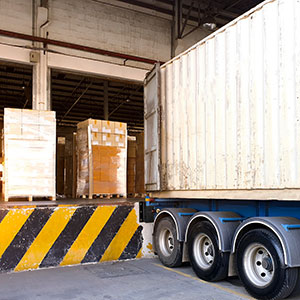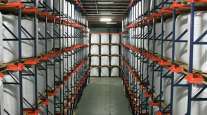Better Planning, Equipment Maintenance Are Key to Improved Loading Dock Efficiency

[Stay on top of transportation news: Get TTNews in your inbox.]
Missed deliveries and driver dissatisfaction are among the headaches fleets endure when the trucks hit the loading docks. In a time when supply chain issues have reached critical mass, trucking and warehouse companies, as well as dock equipment managers, have been searching for solutions for better efficiency.
“I am frequently speaking with drivers about the growing delays at shippers’ docks,” said Deen Albert, director of operations for Grand Island Express, based in Grand Island, Neb. “Although we are constantly reviewing and revising our delay/detention pay to our drivers, this is a growing frustration for drivers and is a threat to driver retention in our industry.”
If just one of a location’s 10 positions isn’t working, the facility is working on just 90% of its productivity.
“Efficiency is about clear, routine operations with reduced manual steps and communication with everyone that is working the dock area including the transportation drivers,” said Gerard Biasutto, director of engineered solutions for Blue Giant Equipment Corp., a loading dock equipment manufacturer based in Toronto.
Decreased efficiency also has a financial cost. Dirk Seis, director of marketing for Ideal Warehouse, a manufacturer of loading dock safety products based in Woodbridge, Ontario, estimated that a non-operating dock burns nearly $1,700 per hour for the company. “That can become a significant cost. Most companies have more than one loading dock,” he said. “You can shift your operations to the other loading dock, but then it is less efficient.”
Advanced planning, equipment upgrades and preventive maintenance can improve the productivity and efficiency of a loading dock. “The loading dock is often an ignored place from a maintenance and equipment standpoint, but it is the first and last entry point for the product,” Seis said.
Heather Dohrn, vice president of sales and marketing at Dohrn Transfer, a unit of Pitt Ohio Transportation Group, said days and even hours added to transit will greatly impact customers, so technology initiatives are centered around improving efficiency.

Dock management technology measurably improves productivity and efficiency, reduces misdirects and increases accountability. (CLI)
Dohrn Transfer, based in Rock Island, Ill., uses automated dock management technology from Carrier Logistics Inc. (CLI), which provides visibility into detailed load and shipment information and potential issues. It expects to see labor savings of more than 16% once full use of CLI’s Dock Management Board and handheld scanners are in place. The technology provides real-time visibility and control over each trailer and dock door, while the mobile component guides the dockworkers as they load, unload and inspect freight, preventing misdirected freight and enabling load plan adjustments.
Less-than-truckload (LTL) operations are based around schedules of departures and arrivals. The dock is the central component keeping those schedules running on time, maximizing available hours of service for drivers.
“Much like the airline industry, the customer expectation is for those flights to depart and arrive timely to make service. LTL is the same in that we must hit our schedules to meet the expectations of our customers,” said Amos Rogan, LTL operations leader of productivity and efficiency at Averitt Express.
Ben Wiesen, president of CLI, based in Elmsford, N.Y., said dock management technology measurably improves productivity and efficiency, reduces misdirects and increases accountability.
For Averitt, planning, utilizing tools and communicating effectively are vital to a productive, efficient and safe dock environment. “If you don’t have a good plan of how shipments are going to be processed, you will see dock associates not moving at their highest potential,” Rogan said.
Averitt’s planning process projects routes and sequences shipments so the fleet can frequently cross-dock more efficiently. “Anyone working the dock will only be as good as the plan they are working with,” Rogan said.
Typically, delays are caused by understaffing, and one of the most significant issues to tackle is workflow, Albert said. “As a carrier, we can see that the staging areas are becoming more and more congested. In certain circumstances, this can be due to a lack of space, but in many circumstances, this is due to an inefficient or overloaded workflow,” he said. “This creates a visual illustration directly to our drivers and adds to the delay concerns that are already mounting.”
Averitt, which is based in Cookeville, Tenn., and ranks No. 36 on the Transport Topics Top 100 list of the largest for-hire carriers in North America, uses planning software connected to its operating system to help create a plan to maintain efficiency. “We also use an in-house program that directs dock associates to select the correct shipment to sequence a delivery route correctly to reduce the handling of a shipment,” Rogan said.
Loading dock infrastructure
Dock design and layout are vital for maximum utilization. “We measure our productivity in not only how many pounds per hour we move across the dock but also how many feet per shipment a dock associate travels,” Rogan said. “If you are stripping trailers on one end of the dock and loading on the other, you’re wasting valuable time traveling back and forth for each shipment.”
That is especially true in larger facilities with more than 100 doors. “You must understand what your customer base is, appointment requirements and volume to determine how you can design a layout that allows for the shortest distance traveled and the most shipments moved in the safest and most efficient way possible,” he continued.
Additionally, having appropriate equipment helps. “The more that can be done to improve efficiency and automation, the better this situation will be,” Albert said.

Fleets like Old Dominion Freight Lines invest heavily in dock equipment to minimize equipment downtime and keep productivity high. (ODFL)
Dave Bates, senior vice president of operations at Old Dominion Freight Line, which is based in Thomasville, N.C., and ranks No. 10 on the TT100, said the fleet is constantly evaluating its processes and technologies to improve a shipment’s journey and has invested in technology on forklifts to improve productivity and lessen congestion and downtime.
“Our dock yard management systems are on each forklift and makes it so that the dockworker can easily load and unload trailers,” Bates said, adding that the information is captured at the dock level and can be communicated to the customer for real-time track and trace.
Bates also noted that ODFL invests heavily in dock equipment — trucks, forklifts, yard switchers — to minimize our equipment’s downtime and keep productivity high. Blue Giant’s Biasutto recommended operators need to keep the end-users and truck-and-trailer fleet mix in mind to help understand heights, widths, load frequency and timing requirements when upgrading an existing facility or designing a new facility.
The way trailer equipment is designed can help improve efficiency at docks as well. Rob Ayers, vice president of U.S. Operations for Leyman Lift Gates, said liftgates on trailers can prove to be a nuisance at the docks or an efficiency. Leyman has focused on its rail gate design to increase accessibility for drivers and dock employees needing to raise and lower the gate.
“We have switches in multiple locations on the back of that truck or trailer where the driver or a dockworker can reach it without having to bend down. It is less twisting and less torquing,” Ayers said.
Preventive Maintenance
Being proactive rather than reactive with maintenance helps keep workflow moving smoothly and avoid unnecessary delays and the rescheduling of loading dock traffic due to breakdowns. Equipment typically needs cleaning and review quarterly and annually to ensure functionality and life expectancy.
“Loading dock equipment handles forceful stresses every day,” Biasutto said. “It should be cleaned, lubricated and checked by a technician to increase product life and productivity, prevent small problems from becoming major complications, and reduce the likelihood of a service call and downtime.”
The best preventive maintenance is performed with planned maintenance programs with a trained OEM technician visiting a facility monthly, quarterly and annually, said Chad Dillavou, director of product management for Rite-Hite Products Corp., based in Milwaukee.
Averitt utilizes in-house preventive maintenance. “We also keep track of any trends associated with opportunities for improvement as well as monitoring the inventory of pallet deck, dunnage and airbags so that replenishment is ahead of demand as much as possible,” Rogan said.

Loading dock bumpers must be applied so the trailer is in the best position for efficient loading. (Ideal Warehouse)
The right equipment can minimize damage, so docks don’t have to be closed for repairs. Seis said loading docks must have bumpers, and bumper technology is improving. “In the old days, bumpers used to be blocks of wood. The latest and greatest designs have componentry in them that allow them to last longer, such as a steel plate, or they move up and down with the action of the trailer that can reduce wear and tear,” he said.
Loading dock bumpers must be applied so the trailer is in the best position for efficient loading. “Dock bumpers can be bought on the internet. If you don’t know how to apply them properly, mistakes can be made,” Seis said.
Safety is critical, and loading docks are among the most dangerous areas of industrial facilities, Dillavou said. “Trailer separation accidents are always a concern, including trailer creep, trailer pop-up, landing gear collapse and early departure, all of which can be fatal to forklift drivers caught in a trailer. Open doors are also a potential danger for forklift drivers while backing trailers are a danger for workers in the drive approach,” he said.
Trailer collapse prevention is increasingly important in loading dock safety, and trailer stands can help improve safety. When the cab pulls away, it leaves the trailer there on its two landing gear legs, Seis explained. If those legs aren’t maintained or there is extensive rocking the trailer can collapse, placing the dock out of service.
When exploring upgrades, cost is often an issue. “While equipment upgrades typically pay for themselves within a relatively short time, the initial investment can be significant,” Dillavou said.
Rite-Hite has taken steps to help companies approach upgrades on a budget-friendly, incremental basis, offering elements as a retrofit or stand-alone equipment. Previously, these multisensory safety alerts were only available with specific products, Dillavou said.
Demands on loading docks are only expected to increase, and Dillavou said the increased pace of e-commerce growth is a challenge. “To keep up with it, this industry will need to evolve and improve, incorporating technology, automation and intelligence within the warehouse/DC environment,” he said.
Want more news? Listen to today's daily briefing below or go here for more info:




